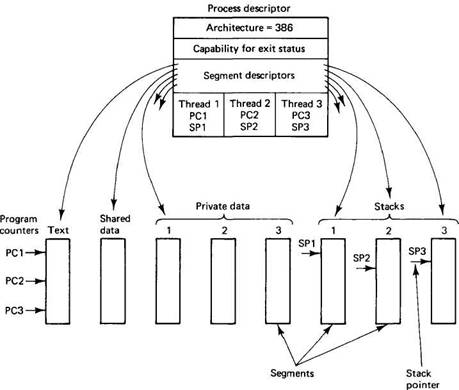Книга: Distributed operating systems
7.3.1. Processes
7.3.1. Processes
A process is an object in Amoeba. When a process is created, the parent process is given a capability for the child process, just as with any other newly created object. Using this capability, the child can be suspended, restarted, signaled, or destroyed.
Process creation in Amoeba is different from UNIX. The UNIX model of creating a child process by cloning the parent is inappropriate in a distributed system due to the considerable overhead of first creating a copy somewhere (FORK) and almost immediately afterward replacing the copy with a new program (EXEC). Instead, in Amoeba it is possible to create a new process on a specific processor with the intended memory image starting right at the beginning. In this one respect, process creation in Amoeba is similar to MS-DOS. However, in contrast to MS-DOS, a process can continue executing in parallel with its child, and thus can create an arbitrary number of additional children. The children can create their own children, leading to a tree of processes.
Process management is handled at three different levels in Amoeba. At the lowest level are the process servers, which are kernel threads running on every machine. To create a process on a given machine, another process does an RPC with that machine's process server, providing it with the necessary information.
At the next level up we have a set of library procedures that provide a more convenient interface for user programs. Several flavors are provided. They do their job by calling the low-level interface procedures.
Finally, the simplest way to create a process is to use the run server, which does most of the work of determining where to run the new process. We will discuss the run server later in this chapter.
Some of the process management calls use a data structure called a process descriptor to provide information about the process to be run. one field in the process descriptor (see Fig. 7-6) tells which CPU architecture the process can run on. In heterogeneous systems, this field is essential to make sure that 386 binaries are not run on SPARCs, and so on.
Another field contains the process' owner's capability. When the process terminates or is stunned (see below), RPCs will be done using this capability to report the event. It also contains descriptors for all the process' segments, which collectively define its address space, as well as descriptors for all its threads.
Finally, the process descriptor also contains a descriptor for each thread in the process. The content of a thread descriptor is architecture dependent, but as a bare minimum, it contains the thread's program counter and stack pointer. It may also contain additional information necessary to run the thread, including other registers, the thread's state, and various flags. Brand new processes contain only one thread in their process descriptors, but stunned processes may have created additional threads before being stunned.
The low-level process interface consists of about a half-dozen library procedures. Only three of these will concern us here. The first, exec, is the most important. It has two input parameters, the capability for a process server and a process descriptor. Its function is to do an RPC with the specified process server asking it to run the process. If the call is successful, a capability for the new process is returned to the caller for use in controlling the process later.

Fig. 7-6. A process descriptor.
A second important library procedure is getload. It returns information about the CPU speed, current load, and amount of memory free at the moment. It is used by the run server to determine the best place to execute a new process. A third major library procedure is stun. A process' parent can suspend it by stunning it. More commonly, the parent can give the process' capability to a debugger, which can stun it and later restart it for interactive debugging purposes. Two kinds of stuns are supported: normal and emergency. They differ with respect to what happens if the process is blocked on one or more RPCs at the time it is stunned. With a normal stun, the process sends a message to the server it is currently waiting for, saying, in effect: "I have been stunned. Finish your work instantly and send me a reply." If the server is also blocked, waiting for another server, the message is propagated further, all the way down the line to the end. The server at the end of the line is expected to reply immediately with a special error message. In this way, all the pending RPCs are terminated almost immediately in a clean way, with all of the servers finishing properly. The nesting structure is not violated, and no "long jumps" are needed.
An emergency stun stops the process instantly and does not send any messages to servers that are currently working for the stunned process. The computations being done by the servers become orphans. When the servers finally finish and send replies, these replies are ultimately discarded.
The high-level process interface does not require a fully formed process descriptor. One of the calls, newproc, takes as its first three parameters, the name of the binary file and pointers to the argument and environment arrays, similar to UNIX. Additional parameters provide more detailed control of the initial state.
- Using the kill Command to Control Processes
- Listing Processes with ps
- 15.4.1. Debugging Multiple Processes
- 8.2.1. Processes
- 9.2.1. Processes
- 9.7.3. Processes
- 1.5.2 A version using multiple processes
- 4 Processes and Processors in Distributed Systems
- Листинг 11.9. (processes.c) Серверный модуль, отображающий таблицу процессов
- Processes and Threads
- Owner match
- 6.3.6. Release Consistency




